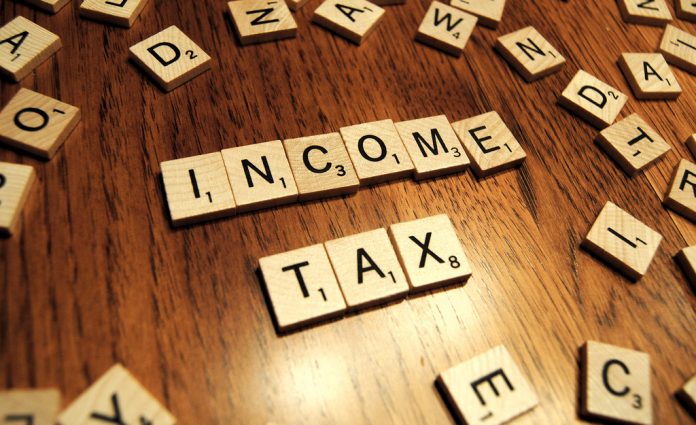This article has been written by Oishika Banerji of Amity Law School, Kolkata. This article discusses Section 115BBA of the Income Tax Act, 1961 which discusses the benefit of a lower corporate tax rate for Indian firms.
it has been published by Rachit Garg.
Table of Contents
Introduction
In order to offer domestic firms lower tax rates, the Government of India introduced Section 115BAA on September 20, 2019, through the Taxation (Amendment) Act 2019, in the Income Tax Act, 1961. Under Section 115BAA, domestic businesses have the option of paying tax at a rate of 22% along with a 10% surcharge and a 4% cess. If the corporation decides to use Section 115BAA, MAT (Minimum Alternate Tax) will not apply. The Income Tax Act of 1961 is modified in some ways by the Indian government. A lowering in the corporate tax rate for domestic and manufacturing businesses was among the stated adjustments made by the amendment Act of 2019. The MAT rate has also decreased from 18.5 percent to 15 percent. In this article, the relevance, scope, objective and requirement of Section 115BAA of the Income Tax Act, 1961 have been discussed.
Role of the Income Tax Act, 1961 on the growth of domestic business
According to Section 2(22A) of the Income Tax Act, 1961, a domestic company is defined as an Indian company or any other company that has established the necessary arrangements for the declaration and payment of dividends (including dividends on preference shares) payable out of such income within the territory of India. A fair analysis would come to the conclusion that well-designed tax policies have the potential to increase economic growth, but there are many roadblocks to overcome and there is absolutely no assurance that all tax adjustments will enhance economic performance. Given the different ways that tax policy influences growth, a tax policy that encourages growth would include:
- Significant beneficial incentive (substitution) effects that promote investment ment, saving, and work;
- Income effects that are marginally good or detrimental, such as carefully directing tax cuts toward new economic activity rather than giving prior activities windfall gains;
- A decrease in distortions among economic sectors, as well as between various income and consumption kinds; and
- Negligible rises in the budget deficit.
Reduction in income tax rates
When income tax rates are reduced, when income tax rates are reduced, both income and substitution effects are witnessed in the economy. Tax rate reductions have a beneficial impact on the growth of the economy because they increase the after-tax benefits of investing, saving, and working. Through the effects of substitution, these increased after-tax returns encourage additional work effort, saving, and investment. Tax reductions often have this “intended” impact on the size of the economy. Pure rate reductions also have the advantage of lowering the value of existing tax distortions and causing a shift in the composition of economic activity away from currently tax-favoured industries like healthcare and real estate, improving efficiency (even when the level of economic activity is held constant). Pure rate reductions, however, may also have favourable income (or wealth) impacts, which lessen the need for work, saving, and investing.
For instance, all of these effects are included in a rate reduction for income taxes across the board. By boosting the marginal return to work, it expands the labour pool due to the substitution effect. It lessens the value of current tax breaks, which is likely to change how the economy is structured. At every level of labour supply, it also increases a household’s after-tax income, which, via the income impact, causes the labour supply to decline. The overall impact on the labour supply is unclear. Tax rate reductions’ effects on saving and other activities have a similar effect.
The government is correct to argue that India is now viewed as a globally competitive economy and a preferred location for investment, and that these decreased rates (under Section 115BAA) are now some of the lowest in the world following the implementation of reduced rates for corporate taxpayers. The average corporate tax rate in Europe is 19.35%, while it is 21.09% in Asia, 27.21% in the Americas, and 28.24% in Africa. Now it just takes a matter of time to see how far the government will get with its goal of encouraging Indian businesses to enter the ambit of “Make in India.”
Tax reform
Tax reform includes both lowering income tax rates and trying to broaden the tax base. This means reducing the use of tax expenditures and other things that narrow the base. Base-broadening will typically result in a rise in the average effective marginal tax rates on labour supply, savings, and investment by eliminating the unique treatment of certain sources of income or consumption.
This has two effects:
- First, truly revenue-neutral tax reform should have no average income effect.
- Second, the average substitution effect will be smaller from a revenue-neutral tax reform than from a tax rate cut because the lower tax rate increases incentives to work, while the base widening decreases such incentives.
Base-broadening also has another impact that should contribute to the growth of the economy. It would specifically decrease the number of resources allocated to the sectors and industries that currently enjoy favourable tax treatment. A system with lower rates and a larger base would encourage resources to flow out of currently tax-favoured industries and into those with better pre-tax returns. The economy would grow in size as a result of the reallocation. Section 115BAA of the Income Tax Act of 1961 is indeed a blessing in the form of tax reform for domestic companies in terms of their operations.
Features of Section 115BAA of the Income Tax Act, 1961
After gathering an idea about tax rate reduction and reformation that the Act of 1961 brings along with it for benefitting domestic companies, the notable features of Section 115BAA need to be taken into consideration, which are provided hereunder:
- An alternative system signifies that application of the discussed provision is not mandatory by nature.
- Corporations have the option to reject concessional tax and switch back to the previous tax system.
- The provision includes the additional cess, and fee and the tax rate is 22%+.
- The corporations must choose to forgo the MAT in order to be eligible to select to participate under Section 115BAA.
Need for Section 115BAA of the Income Tax Act, 1961
The Taxation (Amendment) Act, 2019 was passed by the Government of India on September 20th, 2019, and on that day, Section 115BAA was put into effect. This Act makes a number of changes to the Income Tax Act of 1961. A reduction in the corporate tax rate for both domestic and manufacturing enterprises was among the changes that were announced. Additionally, the MAT rate was lowered from 18.5% to 15%. Under Section 115BAA, domestic enterprises have the choice to pay tax at a rate of 22% plus a surcharge of 10% and a cess of 4%. The effective tax rate will be 25.17% starting in FY 2019–20 (AY 2020–21) if such domestic enterprises meet the requirements. If the corporation chooses Section 115BAA, it is not required to pay tax under MAT.
Which domestic companies are eligible to enjoy the benefit of Section 115BAA
The following requirements must be met in order for all domestic businesses to elect to pay income tax at the rate of 22% (plus any relevant surcharge and cess), as have been provided hereunder:
- Such businesses shouldn’t take advantage of any exclusions or incentives provided by various income tax regulations. As a result, the company’s total income shall be calculated without:
- Claiming any deduction under Section 10AA that is specifically available for units built in special economic zones.
- In the states of Andhra Pradesh, Bihar, Telangana, and West Bengal, claiming additional depreciation under Section 32 and investment allowance under Section 32AD in relation to new equipment built in designated rural regions.
- Claiming a deduction under Section 33AB for businesses that manufacture tea, coffee, and rubber.
- Claiming a deduction for contributions made by Indian enterprises that extract or produce petroleum, natural gas, or both under Section 33ABA to the Site Restoration Fund.
- Claiming a deduction under Section 35 for expenses incurred for scientific research, as well as money given to an IIT, National Laboratory, institution, or research organisation.
- Use Section 35AD to claim a deduction for capital expenditures made by any designated firm.
- Requesting a deduction for the costs associated with a project to extend agriculture under Section 35CCC of a project to improve skills under Section 35CCD.
- Claiming a deduction under Chapter VI-A of the Income Tax Act, 1961 for income that is permitted by Sections 80IA, 80IAB, 80IAC, 80IB, and other similar provisions, with the exception of Sections 80JJAA and 80M.
- Claiming a deduction under Chapter VI-A for income that is permitted under Sections 80IA, 80IAB, 80IAC, 80IB, and other similar provisions, but not Section 80JJAA.
- Claiming a set-off for any losses that have been carried over or depreciation from prior years, if such losses relate to the deductions mentioned above.
- A deduction for additional/accelerated depreciation; a claim by an amalgamated company for set-off of carried forward loss or unabsorbed depreciation belonging to an amalgamating firm, if such loss or unabsorbed depreciation is due to the foregoing deductions. However, the typical depreciation may be claimed.
- If the corporation chooses Section 115BAA, then the chance to claim set off is permanently gone. The aforementioned losses shall be assumed to have been allowed and shall not be available for carry forward and set off in later years.
- These businesses must use this option in order to be subject to taxation under Section 115BAA on or before the deadline for filing income tax returns, which is typically September 30 of the assessment year. The due date has been moved up to February 15, 2021, for the AY 2020–2021. Once a firm chooses to use Section 115BAA during a specific fiscal year, that choice cannot be changed later. The CBDT has advised that the choice is in Form 10-IC. Online submission of the form is required, either with a digital signature or an electronic verification code.
- Any existing company can transition into this sector at any time; there are no turnover restrictions and the company does not need to be brand-new.
Detailed analysis of Section 115BAA of the Income Tax Act, 1961
Section 115BAA of the Income Tax Act, 1961 comprises five clauses with each addressing a different factor associated with the provision and together upholding the legislative intent behind the provision. The clauses have been discussed below,
Section 115BAA (1) of the Income Tax Act, 1961
In accordance with Chapter XII’s provisions, in addition to those mentioned under Sections 115BA and 115BAB, if all of the requirements outlined in subsection (2) are met, the income tax owed with respect to a person’s total income for any prior fiscal year relevant to the assessment year that starts on or after April 1, 2020, will be computed at 22%. A list of special income tax rates under Chapter XII has been provided hereunder:
- Tax on Long-Term Capital Gains (Section 112).
- Tax on Short-Term Capital Gains in certain cases (Section 111A).
- Tax on dividends, royalties, and fees for technical services in the case of foreign companies (Section 115A).
- Tax on Long Term Capital Gains in certain cases (Section 112A).
- Tax on income from bonds or GDRs purchased in foreign currency or capital gain arising from their transfer (Sections 115AC/ 115ACA).
- Tax on winnings from lotteries, crossword puzzles, and races including horse races (Section 115BB).
- Tax on income from virtual digital assets (Section 115BBH).
- Tax on income from transfer of carbon credits (Section 115).
The aforementioned provisions make it clear that a corporation choosing this new tax regime under Section 115BAA will be subject to the rates of the special tax included for a number of transactions in Chapter XII. A firm cannot prefer the concessional tax rate under identical Sections 115BA or 115BAB of the Income Tax Act after choosing the concessional tax rate under Section 115BAA of that law.
The provisio to sub-section (1) of Section 115BAA says that if a domestic corporation wants to use the tax breaks in that section, it has to meet a number of requirements. The proviso to Section 115BAA(1) says that this option is illegal for the current and subsequent assessment years if the company was unable to meet these requirements in any prior financial year. Additionally, their income will be evaluated to make sure they haven’t taken advantage of the opportunity to pay less tax for that assessment period and the one after it.
Section 115BAA (2) of the Income Tax Act, 1961
As previously stated, a domestic corporation is qualified to choose the favourable tax regime provided by this section if they meet the requirements outlined in subsection (2) of Section 115BAA. If a domestic corporation opts for the reduced tax rate under Section 115BAA, it must forgo the following exemptions or deductions:
- Section 10AA: Deduction to new units that have been established in SEZ.
- Section 32(1)(iia): Benefits of accelerated depreciation of 35% or 20%.
- Section 32AD: Investment Allowance for investment in machinery and plant in the backward areas that have been notified.
- Section 33AB: Deduction related to the development account of coffee, tea, or rubber coffee.
- Section 33ABA: Deductions that are related to the site restoration fund.
- Section 35(1):
- Deduction for money paid to particular research associations at a university, college, or another research facility.
- Deduction pertains to the amount paid to a firm to be used for scientific research.
- Deduction for any money provided to organisations, universities, or institutions that do research in the social sciences or statistics.
- Section 35(2AA): Deductions are connected to money paid to a national lab, college, IIT, or a specific individual who will be involved in scientific research for a project that has been approved.
- Section 35(2AB): Deductions for any type of cost incurred by a company involved in the manufacture, production, or processing of goods, as defined in the Eleventh Schedule, on an internal scientific development and research facility.
- Section 35AD: Tax deductions for depreciation on capital expenses incurred by a specific type of business.
- Section 35CCC: Deductions pertaining to the agricultural extension project.
- Section 35CCD: Deductions for costs incurred in a skill-development initiative.
- Deductions under Chapter VIA: Domestic corporations that use Section 115BAA are not permitted to deduct the expenses listed in Chapter VIA. However, the following deductions are possible:
- Section 80JJAA: Deductions for the hire of new personnel.
- Section 80M: Deductions for dividends paid to other corporations.
- Additionally, if a domestic corporation opts for Section 115BAA, it must determine its total income without deducting any losses carried forward or deductions from assessment years earlier to this one, if the loss or depreciation is related to one of the above-mentioned deductions.
- If any allowance or loss for an unabsorbed deduction is attributable to one of the above-mentioned deductions, the total income should be calculated without deducting it.
- In addition to the additional depreciation under Section 32 (1) (iia), the total income of a corporation that elects to use Section 115BAA should be determined by permitting the deduction, if any, in accordance with Section 32’s rules.
Section 115BAA (3) of the Income Tax Act, 1961
When a corporation opts for Section 115BAA of the Income Tax Act, any unabsorbed depreciation or losses from prior years that are connected to the non-deductible expenses under Section 115BAA (2) will expire and cannot be claimed in the years that follow. The fact that all carried forward depreciation and losses will cease to be deductible has the taxpayers perplexed. It has been made clear that, for a corporation that chooses Section 115BAA, there are no limitations on carrying forward and offsetting losses or depreciation. The only limitation is on things that are prohibited by Section 115BAA (2).
According to the proviso to subsection (3), domestic corporations with unabsorbed deductions are required to make the appropriate adjustment to the written down value (WDV) of certain blocks of assets as of April 1, 2019. If the corporation uses the option provided by Section 115BAA, then this is valid.
Section 115BAA (4) of the Income Tax Act, 1961
Domestic corporations cannot use Chapter VIA deductions for determining their total revenue if they choose the tax regime under Section 115BAA. The deductions indicated in Sections 80JJAA and 80M are the only exceptions provided by Section 115BAA (2).
A unit in the Indian Financial System Code (IFSC) is permitted to deduct 100% of the income indicated in clause (2) of this particular provision (Section 115BAA) under Section 80LA of the ITA. A unit in the IFSC must give up the benefit of the deduction under Section 80LA with regard to Section 115BAA if it decides to take the deduction under Section 115BAA (2). This is where subsection (4) is applicable.
The unit in the IFSC that chooses Section 115BAA is permitted to benefit from deductions under Section 80LA up to 100% of its income for a continuous period of ten years out of the initial 15 years, as per subsection 4 of Section 115BAA. Consequently, a unit in the IFSC may subtract the following expenses from its total income:
- Normal Depreciation.
- Deduction under Section 80M.
- Deduction under Section 80JJAA.
- Deduction under Section 80LA
Section 115BAA (5) of the Income Tax Act, 1961
- According to this clause, a domestic firm may only profit from a reduced tax rate if they want to do so.
- In order to exercise the option, they must file Form 10-IC on or before the deadline set forth in Section 139(1) of the Act of 1961.
- For the current and succeeding assessment years, the option cannot be revoked once it has been exercised.
The proviso to Section 115BAA (5) specifies that a corporation may now choose Section 115BAA if it previously exercised the option under Section 115BAB and it was invalidated due to any of the reasons listed above. Because of the invalidation under one provision, the corporation is not ineligible to choose a benefit under another section. Sections 115BAA and 115BAB function separately.
Conditions that are applicable under Section 115BAA of the Income Tax Act, 1961 on domestic companies
Every domestic corporation is now eligible to pay income tax at a rate of 22% (applicable cess plus surcharge) under the new taxation system. However, these corporations must consider the following deductions in accordance with the Income Tax Act of 1961:
- Under Section 10A deductions for special economic zones (SEZ).
- Deductions under Section 35 for money spent at any university on scientific research.
- Deductions for tea, rubber, and coffee under Section 33AB.
- In addition to the parts of Sections 80 LA, 80JJAA, and 80M, deductions that come within Chapter VI A.
- The investment made by a specific company under Section 35AD.
- Concessions resulting from losses and unreimbursed depreciation fall under Section 72A.
- Deductions under sections 35CCC and 35CCD for costs incurred as a result of programmes for agriculture extension or skill development.
- Additional depreciation falls under Section 32A as well as the investment allowance for establishing industries (Section 32AD) in the identified underdeveloped regions of Telangana, Bihar, West Bengal, and Andhra Pradesh.
A corporation that chooses Section 115BAA has an effective tax rate that is slightly lower, but these corporations are not eligible for the other tax benefits specified in the Act of 1961. Few of the deductions, exemptions, incentives, and other depreciations listed in the ITA, 1961, can be claimed by corporations if they opt not to use Section 115BAA.
How should a domestic company apply Section 115BAA to its advantage
Corporations may use Section 115BAA in accordance with Rule No. 21AE. They must submit Form 10-IC of the Income Tax Act, 1961 in order to choose this option. It mostly consists of the decisions that must be taken and the requirements that must be presented electronically using an e-verification code or a digital signature certificate.
According to Section 139(1) of the Income Tax Act, 1961, it must be filed on or before the deadline for filing income tax returns. For domestic enterprises that must abide by transfer pricing regulations, the deadline is the 30th of November of each assessment year, while for other businesses it is the 31st of October. If the following criteria are satisfied, any domestic firm has the option of paying its income tax at a rate of 22%.
Can a domestic company exclude itself from the application of Section 115BAA of the Income Tax Act, 1961 on it
Domestic businesses can choose to take advantage of this discounted rate after their tax holidays, exemptions, or incentives, as described in point B above, have expired if they do not want to do so right away. When their tax deduction period expires, they must complete it. The concessional tax rate under Section 115BAA of the Income Tax Act of 1961, however, cannot be later removed by such a firm.
Conclusion
On September 20, 2019, the Government of India introduced the Taxation Laws (Amendment) Act, 2019, which reduced the corporate tax rates to 22% for existing domestic companies and 15% for new domestic manufacturing companies, among other fiscal reliefs, in an effort to draw new investment into the manufacturing sector and thereby support the “Make-in-India” initiative. After corporate tax rates were reduced, India became the nation with the lowest corporation tax rate when compared to other major nations. If a firm chooses this option, it must forgo any applicable exemptions or deductions that would otherwise be available to companies that do not choose this option. This stage simplifies the difficult process of determining the applicability of all exemptions and deductions available to the company and then fulfilling their requirements; the company is no longer obliged to carry out such onerous work and is just required to pay tax at a lower rate.
Domestic firms that want to take advantage of the lower income tax rates available under Section 115BAA of the Income Tax Act of 1961 must meet a few requirements in order to be eligible. Existing businesses are free to switch to the tax rates stated in this section at any time. They cannot, however, take advantage of additional benefits offered by the Act of 1961 if they choose a new taxation system over the one that is now in place.
References
- https://www.incometax.gov.in/iec/foportal/help/company/return-applicable.
- https://www.brookings.edu/wp-content/uploads/2016/06/09_effects_income_tax_changes_economic_growth_gale_samwick.pdf.
- https://taxguru.in/income-tax/reduced-corporate-tax-rate-new-section-115baa-115bab.html.
Students of Lawsikho courses regularly produce writing assignments and work on practical exercises as a part of their coursework and develop themselves in real-life practical skills.
LawSikho has created a telegram group for exchanging legal knowledge, referrals, and various opportunities. You can click on this link and join:
Follow us on Instagram and subscribe to our YouTube channel for more amazing legal content.
 Serato DJ Crack 2025Serato DJ PRO Crack
Serato DJ Crack 2025Serato DJ PRO Crack











 Allow notifications
Allow notifications



